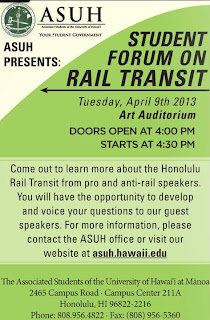Paris, France
French Wreck Reveals Hidden Danger in Its Vaunted Train System
Washington, DC, USA
Obama Administration Puts Brakes on XpressWest High-Speed Rail Project
This is the California-Nevada High Speed Rail proposal.
Honolulu, HI, USA
Federal Judge slaps HART hard by revealing profound contradictions and stupidity. Excerpts from Judge Mollway's letter to HART below.
"On behalf of the United States District Court for the District of Hawaii, I submit that the Draft Supplemental EIS fails to give adequate consideration to the Beretania Street Tunnel Alternative.
Remarkably, the Project's proposed rail route fails to run along "the highly
congested east-west transportation corridor between Kapolei and UH Manoa," the very
corridor expressly identified as the route the Project is intended to serve.
The EIS unrealistically posits that a UH student, after riding the rail to Ala Moana, can transfer to a bus to get to the UH campus and, even including the time spent getting to the bus boarding area and waiting for the bus, arrive within 9 minutes.
North American urban transit security (July 11 headlines)
French Wreck Reveals Hidden Danger in Its Vaunted Train System
Washington, DC, USA
Obama Administration Puts Brakes on XpressWest High-Speed Rail Project
This is the California-Nevada High Speed Rail proposal.
Honolulu, HI, USA
Federal Judge slaps HART hard by revealing profound contradictions and stupidity. Excerpts from Judge Mollway's letter to HART below.
"On behalf of the United States District Court for the District of Hawaii, I submit that the Draft Supplemental EIS fails to give adequate consideration to the Beretania Street Tunnel Alternative.
Remarkably, the Project's proposed rail route fails to run along "the highly
congested east-west transportation corridor between Kapolei and UH Manoa," the very
corridor expressly identified as the route the Project is intended to serve.
The EIS unrealistically posits that a UH student, after riding the rail to Ala Moana, can transfer to a bus to get to the UH campus and, even including the time spent getting to the bus boarding area and waiting for the bus, arrive within 9 minutes.
- Waianae to UH Manoa via Beretania Street Tunnel: 84 minutes
- Current Route of the Project: 93 minutes"
- Waianae to UH Manoa via Beretania Street Tunnel: 84 minutes
- Current Route of the Project: 100 minutes
North American urban transit security (July 11 headlines)
|
ON: All GO Transit Riders Rescued From Flooded Train: Toronto Police
Hundreds of passengers that were stranded on a flooded GO Transit rush-hour train following heavy rain have been rescued, Toronto police said early Tuesday morning. |
|






11624.jpg)



























